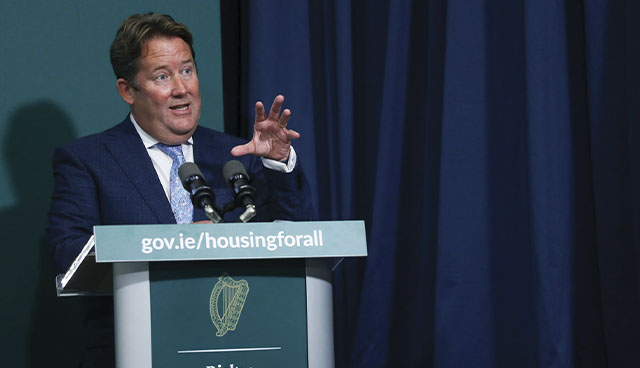The use of emergency planning powers

The Government is to use emergency planning powers in order to house refugees fleeing conflict in Ukraine. eolas analyses how and when these powers are and are not utilised.
In March 2022, as millions of people began to leave Ukraine to escape the Russian invasion, Minister for Housing, Local Government and Heritage Darragh O’Brien TD wrote to local authority chief executives to inform them that provisions in the Planning and Development Act 2000 mean that certain developments can be initiated without a planning application under emergency conditions. These developments are being mooted as an answer to accommodating the up to 100,000 refugees expected to come to Ireland.
The provision to which O’Brien was referring to is Part XI, section 179 (6)(b) of the 2000 Act, which deals with developments by local and state authorities. The section states that the rules and guidelines for planning listed “shall not apply to proposed development which is necessary for dealing urgently with any situation the manager considers is an emergency situation calling for immediate action”.
The indeterminate language within the Act, which does not specify what constitutes an emergency and instead allows managers of these developments to determine for themselves, means that the powers can be used across a broad range of planning. As O’Brien’s letter to local authorities highlights, emergency planning powers were previously used in response to the Covid-19 pandemic, facilitating the construction of temporary hospitals, step-down facilities, healthcare facilities, vaccination and testing facilities, ancillary infrastructure, and other related works.
“It is likely that these powers may have to be availed of again to address the accommodation and other requirements associated with managing the needs of those fleeing the conflict in Ukraine,” O’Brien wrote in his letter.
At the time of O’Brien writing the letter, 600 people had already arrived in Ireland from war-torn Ukraine, and the number of refugees Ireland is expected to take on is at least 20,000 refugees. Individual people and families have already volunteered to accommodate refugees, but the Government’s invocation of emergency powers will see it make use of the myriad of vacant properties and hotels in Ireland.
Speaking on RTÉ Radio One, Minister of State for Enterprise, Trade and Employment Damien English TD said: “We will be looking at vacant properties, we will be looking at hotels and other forms accommodation, temporary accommodation, and more structured accommodation. We will be able to use emergency powers, if need be, under planning laws and supports coming through Europe as well to respond to this.”
“I think it is right that Europe has opened its doors. Anybody I speak to from around the country would say this is an important response first of all, building on the sanctions, building on the support.”
“115 homeless people died in Dublin in 2021, more than double that of 2019; when such figures are placed beside the vacant dwelling figures and the promises of the invocation of special powers for one group experiencing crisis but not another, they are certain to leave bitter tastes in mouths nationwide, to no fault of the refugees availing of the accommodation rightfully offered to them.”
While nobody would deny that both Covid and the refugees fleeing Ukraine represent separate emergencies, the invocation of the powers has caused controversy in Ireland, primarily over the idea of what does or does not constitute an emergency. In 2019, official homelessness figures in Ireland reached over 10,000, a figure of previously unthought of proportions, for the first time ever; given that these official figures only record the numbers of homeless people who access official government services, the likelihood is that the true number had been above 10,000 for some time before that.
A Dáil response provided by then-Minister for Housing, Planning and Local Government Eoghan Murphy TD to Richard Boyd-Barrett TD in July 2019 pointed to estimates by GeoDirectory (a combination of An Post and Ordinance Survey Ireland) that there were 95,076 vacant address points or units in Ireland as of December 2018.
The most recent GeoDirectory Residential Buildings Report (Q4 2021) estimates there to be 90,158 vacant dwellings in Ireland and an additional 22,096 derelict residential units. Following a reduction of homelessness numbers during the Covid-19 pandemic beneath 9,000, the total number of homeless people accessing emergency accommodation in the State exceeded 9,000 again in November 2021 for the first time since April 2020, totalling 9,099.
If the number of refugees arriving from Ukraine was to hit the halfway point of the estimates of between 20,000 and 100,000 – an unlikely situation – this would leave 69,099 people requiring urgent access to accommodation. With the addition of the estimated 7,000 people living in direct provision, this equates to 76,099 people. Data released by the Dublin Regional Homeless Executive showed there to have been 115 homeless people who died in Dublin in 2021, more than double that of 2019; when such figures are placed beside the vacant dwelling figures and the promises of the invocation of special powers for one group experiencing crisis but not another, they are certain to leave bitter tastes in mouths nationwide, to no fault of the refugees availing of the accommodation rightfully offered to them.
Similarly, with emergency powers appropriately invoked to deal with the pandemic, citizens would be forgiven for asking why they had been so long in coming in healthcare. Figures released before the pandemic, in November 2019, showed the State exhibited hospital waiting lists eight times worse than England relative to population in terms of patients waiting less than a year, and 100 times worse for those waiting over a year; these figures were recorded after a fall in total numbers due to spending of €75 million by the National Treatment Purchase Fund, purchasing private treatments for those on waiting lists.
Waiting lists then had over 600,000 patients; over 900,000 were reported to be waiting in September 2021. It is conceivable that this too constitutes an emergency that requires the opening of temporary hospitals.





